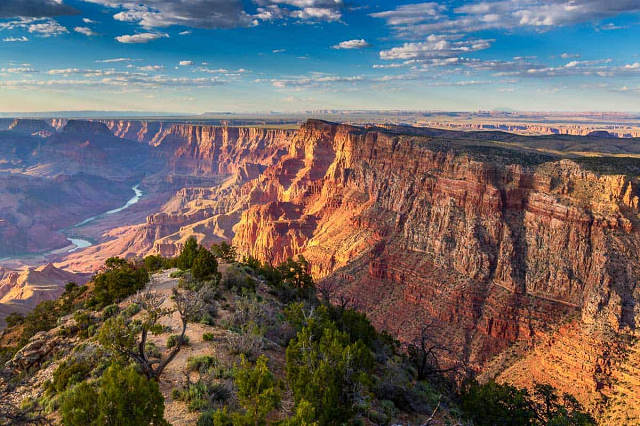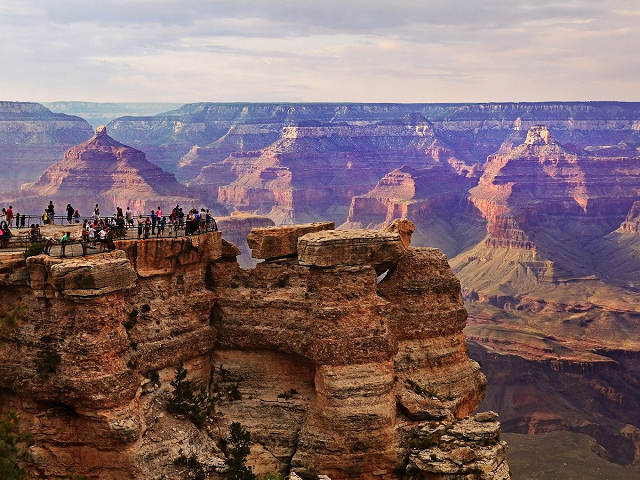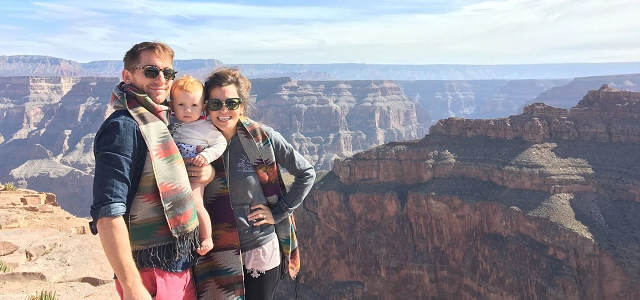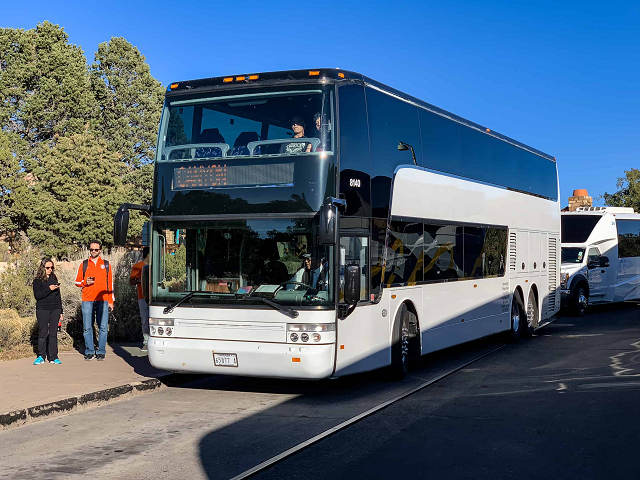las vegas to grand canyon tours bus The Grand Canyon stands as one of the most awe-inspiring and iconic natural wonders in the world. Carved by the mighty Colorado River over millions of years, this colossal geological marvel showcases a breathtaking display of layered rock formations and vibrant colors that never fail to leave visitors in utter amazement.
If you’re looking for an extraordinary adventure from Las Vegas that combines the thrill of exploration with the comfort of guided travel, a bus tour to the Grand Canyon is the perfect choice. This comprehensive article aims to delve into the splendor of such bus tours, providing you with all the information you need to embark on this unforgettable journey.
From the captivating history of the Grand Canyon to the diverse array of activities awaiting you, this guide will leave no stone unturned. We’ll explore the advantages of bus tours, essential tips for preparation, the best itineraries to make the most of your visit, and much more. Whether you’re a seasoned hiker, a photography enthusiast, or simply an admirer of nature’s grandeur, the Grand Canyon has something truly exceptional to offer.
So, get ready to embark on a remarkable expedition, where you’ll be enchanted by the wonders of the Grand Canyon, connect with its rich cultural heritage, and capture memories that will last a lifetime. Let’s delve into the fascinating world of Las Vegas to Grand Canyon bus tours, where natural wonder and spectacular landscapes await at every turn.
Understanding the Grand Canyon

A. Geographical Location and Size of the Grand Canyon
The Grand Canyon is located in the northwestern part of Arizona, USA. It stretches across an impressive 277 miles (446 kilometers) in length, with a width varying from 4 to 18 miles (6.4 to 29 kilometers). The canyon’s depth reaches a staggering 1 mile (1.6 kilometers) at its deepest point, making it a truly monumental natural wonder.
B. Formation and Geological History of the Canyon
Understanding how the Grand Canyon was formed is like reading a geological storybook that spans millions of years. The primary force behind its creation is the Colorado River, which relentlessly cut through layers of rock over a remarkable 6 million years. The layers exposed within the canyon walls reveal the Earth’s geological history, dating back over 2 billion years. From ancient marine fossils to evidence of desert environments, the Grand Canyon is a geological treasure trove.
C. Unique Features and Attractions within the Canyon
- South Rim: The South Rim is the most visited part of the Grand Canyon and offers awe-inspiring panoramic views. Popular viewpoints like Mather Point and Yavapai Observation Station provide breathtaking vistas that leave visitors spellbound.
- North Rim: The North Rim, less accessible but equally captivating, presents a more remote and wilder experience. Its higher elevation provides cooler temperatures and distinct plant and animal life.
- Havasu Falls: Located within the Havasupai Indian Reservation, Havasu Falls is a mesmerizing turquoise waterfall that cascades into striking travertine pools, creating an enchanting oasis amidst the desert landscape.
- Phantom Ranch: Situated at the bottom of the canyon near the Colorado River, Phantom Ranch is a popular destination for hikers and offers rustic lodging for those looking to experience the canyon from within.
- Desert View Watchtower: This historic stone tower, designed by Mary Colter, offers an incredible vantage point to admire the canyon’s vastness and serves as a tribute to the ancestral Puebloan people.
- Colorado River Rafting: The Colorado River presents an opportunity for thrilling rafting adventures, allowing visitors to experience the canyon’s magnitude from a unique perspective.
- Grand Canyon Skywalk: Located at the West Rim, the Skywalk is a transparent horseshoe-shaped bridge that extends over the canyon, offering adrenaline-pumping views of the gorge below.
- Toroweap Overlook: A more remote and less-visited area of the Grand Canyon, the Toroweap Overlook provides striking sheer drop-offs and jaw-dropping vistas.
- Cape Royal: Another gem on the North Rim, Cape Royal boasts stunning panoramic views and is particularly famous for its mesmerizing sunset scenes.
The Grand Canyon’s uniqueness lies not only in its geological features but also in the immense diversity of plant and animal life that call this vast chasm home. From soaring eagles to elusive bighorn sheep, the canyon’s ecosystem supports an array of fascinating wildlife.
As we dive deeper into the allure of Grand Canyon bus tours, keep in mind that this magnificent landscape is a testament to the immense power of nature and a testament to the significance of preserving such treasures for generations to come.
The Appeal of Bus Tours

A. Convenience and Comfort of Bus Travel
- Stress-free Transportation: Bus tours from Las Vegas to the Grand Canyon provide a convenient and hassle-free mode of transportation. No need to worry about driving or navigating unfamiliar roads; simply sit back, relax, and enjoy the journey.
- Spacious and Comfortable Seating: Modern tour buses are designed with comfort in mind, featuring spacious seating, air conditioning, and ample legroom, ensuring a pleasant and relaxing ride throughout the trip.
- Onboard Amenities: Many bus tour operators offer onboard amenities, such as restrooms, Wi-Fi, and charging outlets, to enhance the overall travel experience.
B. Expert Guides and Narrated Tours
- In-depth Knowledge: Bus tours come with knowledgeable guides who are well-versed in the history, geology, and cultural significance of the Grand Canyon. Their insights and stories add depth and context to the sights, making the journey not only visually captivating but intellectually enriching as well.
- Engaging Narration: The guides’ engaging narrations keep passengers entertained and informed throughout the tour, ensuring that every moment is educational and entertaining.
C. Inclusion of Essential Amenities During the Journey
- Meals and Refreshments: Many bus tours include meals or snacks as part of the package, ensuring that travelers stay well-fed and energized during the day’s adventures.
- Rest Stops: Scheduled rest stops allow passengers to stretch their legs, use restroom facilities, and purchase souvenirs or snacks along the way.
- Itinerary Planning: Bus tours are meticulously planned, maximizing the time spent at key locations while allowing for a comfortable pace, ensuring that travelers get the most out of their Grand Canyon experience.
D. Safety and Reliability
- Professional Drivers: Bus tour operators employ experienced and skilled drivers who are trained to navigate the scenic routes to the Grand Canyon safely.
- Compliance with Regulations: Reputable tour companies prioritize the safety of their passengers and comply with all necessary regulations and safety standards.
E. Opportunity to Socialize and Make New Friends
- Group Experience: Bus tours offer a group experience, allowing travelers to meet like-minded individuals who share a passion for exploration and adventure.
- Bonding Moments: The shared experience of discovering the Grand Canyon creates a unique opportunity for passengers to connect and make lasting memories together.
F. Cost-Effective Option
- All-Inclusive Packages: Bus tour packages often include transportation, park entry fees, guided tours, and some meals, making them a cost-effective option for exploring the Grand Canyon.
- No Hidden Costs: With the details of the tour clearly outlined beforehand, travelers can budget effectively without worrying about unexpected expenses.
Overall, the appeal of bus tours lies in their ability to provide a seamless and captivating journey to one of the world’s most stunning natural wonders. Whether you’re a solo traveler, a family, or a group of friends, a bus tour from Las Vegas to the Grand Canyon promises an unforgettable adventure filled with breathtaking landscapes, enriching experiences, and cherished camaraderie.
Choosing the Best Bus Tour

When it comes to embarking on a memorable journey from Las Vegas to the Grand Canyon, selecting the right bus tour can make all the difference. With several tour operators offering various packages, it’s essential to consider certain factors to ensure you have the best possible experience. Here’s a comprehensive guide to help you choose the perfect bus tour for your Grand Canyon adventure:
A. Comparison of Different Bus Tour Operators from Las Vegas
- Researching Tour Companies: Begin by researching reputable tour operators that specialize in Grand Canyon bus tours. Look for companies with a proven track record of excellent service and positive customer reviews.
- Tour Offerings and Itineraries: Compare the tour itineraries of different operators to see which ones align with your preferences and interests. Some tours may focus on specific areas of the canyon or offer unique experiences, so choose one that suits your desired exploration style.
B. Factors to Consider When Selecting a Tour Package
- Duration of the Tour: Decide how much time you want to spend on the tour. Some tours are single-day excursions, while others may span multiple days, providing a more comprehensive exploration of the Grand Canyon.
- Inclusive Stops and Sightseeing Opportunities: Check the stops and sightseeing opportunities included in each tour. Look for tours that visit both the South Rim and the West Rim of the Grand Canyon, as each offers distinct viewpoints and attractions.
- Additional Activities or Add-ons Available: Consider whether the tour offers optional add-on activities such as helicopter rides, rafting trips, or visits to other nearby landmarks. These additional experiences can enhance your overall adventure.
- Customer Reviews and Ratings: Read customer reviews and ratings to gauge the overall satisfaction of previous travelers. Look for feedback regarding the tour guide’s knowledge, the quality of the itinerary, and the level of comfort provided during the journey.
C. Special Considerations
- Accessibility: If you have any mobility concerns or special requirements, check if the tour operator can accommodate your needs.
- Family-Friendly Options: If you’re traveling with children, look for family-friendly tours that cater to younger explorers and offer activities suitable for all ages.
- Group Size: Consider the group size of the tour. Smaller groups may allow for a more intimate experience, while larger groups can offer more opportunities to meet fellow travelers.
- Price and Inclusions: Compare the prices of different tours and what each package includes. Ensure there are no hidden costs and that the tour covers essential expenses like park entry fees.
D. Environmental Responsibility and Sustainability
- Responsible Tourism Practices: Consider choosing a tour operator that emphasizes responsible and sustainable tourism practices, ensuring minimal impact on the fragile ecosystem of the Grand Canyon.
- Supporting Local Communities: Some tour operators may have partnerships with local communities or indigenous groups, contributing to the preservation of cultural heritage and sustainable development.
By carefully evaluating these factors, you can make an informed decision and select the ideal bus tour that aligns with your preferences, interests, and budget. Remember, choosing the best tour will set the stage for an unforgettable journey through the awe-inspiring landscapes of the Grand Canyon.
Preparing for the Journey

Before embarking on your exciting bus tour from Las Vegas to the Grand Canyon, taking the time to prepare adequately will ensure a smooth and enjoyable experience. Here’s a comprehensive guide to help you get ready for your unforgettable adventure:
A. Packing Essentials for a Day Trip to the Grand Canyon

- Comfortable Clothing: Dress in layers to accommodate changing temperatures throughout the day. Comfortable walking shoes are essential for exploring the canyon’s trails and viewpoints.
- Sun Protection: Pack a wide-brimmed hat, sunglasses, and sunscreen with a high SPF to shield yourself from the strong desert sun.
- Water and Snacks: Stay hydrated during the tour by bringing an ample supply of water. Snacks like granola bars and fruits are great for keeping energy levels up.
- Camera and Binoculars: Capture the breathtaking beauty of the Grand Canyon with a quality camera and don’t forget binoculars to enhance your wildlife and landscape sightings.
- Identification and Documents: Carry a valid ID, and if required, ensure you have your passport or travel documents for any border-crossing tours.
B. Tips for a Comfortable and Enjoyable Bus Ride

- Arrive Early: Be punctual and arrive at the designated meeting point early to avoid any delays.
- Carry Entertainment: Bring a book, music, or other forms of entertainment to enjoy during downtime on the bus.
- Travel Pillow and Blanket: Consider bringing a travel pillow and a small blanket for added comfort during the journey.
- Motion Sickness Medication: If you’re prone to motion sickness, pack some medication to alleviate any discomfort.
- Engage with Fellow Travelers: Take the opportunity to socialize and interact with other passengers, enhancing the overall enjoyment of the trip.
C. Understanding Weather Conditions at the Canyon
- Seasonal Variations: The Grand Canyon experiences varying weather conditions throughout the year. Summers can be hot, while winters can be chilly, especially at higher elevations. Research the forecast for your travel dates and pack accordingly.
- Rainy Season: During the monsoon season (typically July to September), be prepared for brief but intense thunderstorms. Bring a light rain jacket or poncho to stay dry.
- Altitude Effects: The Grand Canyon’s higher elevations may cause altitude-related discomfort for some individuals. Stay hydrated and take it easy on the first day to acclimate to the altitude.
D. Safety Precautions
- Follow Park Guidelines: Abide by all rules and guidelines set by the National Park Service to ensure your safety and the preservation of the environment.
- Stay on Designated Paths: When exploring the canyon, stick to designated trails and viewpoints to avoid hazardous areas.
- Listen to Guides: Pay attention to the instructions given by your tour guide, especially regarding safety measures during various activities.
- Emergency Contact Information: Keep emergency contact details and the tour operator’s information handy.
By adequately preparing for your bus tour to the Grand Canyon, you can focus on absorbing the majestic sights and immersive experiences that await you. Enjoy the journey of a lifetime as you delve into the wonders of one of nature’s most extraordinary creat
The Itinerary: Day-by-Day Exploration

Embarking on a bus tour from Las Vegas to the Grand Canyon promises an adventure of a lifetime, as you traverse through stunning landscapes and immerse yourself in the wonders of this iconic natural marvel. Here’s a day-by-day breakdown of what to expect during your journey:
Day 1: Departure from Las Vegas
- Introduction and Orientation: Meet your fellow travelers and tour guide at the designated departure point in Las Vegas. Get introduced to the group and receive an overview of the exciting days ahead.
- Safety Briefing: Your tour guide will conduct a safety briefing, ensuring everyone is aware of safety measures and guidelines to follow throughout the trip.
- Scenic Sights en route: As you depart from Las Vegas, witness the breathtaking desert scenery of Nevada, including unique rock formations and expansive landscapes.
- Photo Stops: Make stops at scenic viewpoints along the way, providing opportunities to capture photos of the striking desert vistas.
- Comfort Breaks: Planned rest stops offer a chance to stretch your legs, use restroom facilities, and purchase snacks or souvenirs.
Day 2: Arrival at the Grand Canyon National Park – South Rim
- Sunrise at the South Rim: Rise early to witness the captivating sunrise over the Grand Canyon from one of the South Rim’s panoramic viewpoints, a truly unforgettable experience.
- Exploration of South Rim Viewpoints: Spend the day exploring the various viewpoints along the South Rim, such as Mather Point, Yavapai Observation Station, and Desert View Watchtower. Each offers unique perspectives of the canyon’s majestic beauty.
- Optional Activities: Depending on the tour package, you might have the option to partake in activities like guided hikes along the Rim Trail, attending ranger-led talks, or visiting the Grand Canyon Village.
Day 3: Visiting the West Rim
- Scenic Drive to the West Rim: Today, journey to the West Rim of the Grand Canyon, passing through diverse desert landscapes and witnessing the changing scenery.
- Highlights of the West Rim: Explore the West Rim’s key attractions, including the famous Grand Canyon Skywalk. Dare to walk on the transparent horseshoe-shaped bridge, offering thrilling views of the canyon floor below.
- Helicopter Tour (Optional): Consider an optional helicopter tour for an exhilarating aerial view of the Grand Canyon’s vastness and dramatic cliffs.
- Hiking and Photography: Engage in short hikes and capture extraordinary photographs of this unique section of the canyon.
Day 4: Return Journey to Las Vegas
- Recap of the Tour Experience: On the return journey to Las Vegas, take the time to share your favorite moments and experiences with your fellow travelers.
- Final Moments at the Grand Canyon: Savor your last moments at the Grand Canyon as the bus makes its way back, cherishing the memories created during this incredible adventure.
- Arrival in Las Vegas: Arrive back in Las Vegas, with hearts full of wonder and memories to last a lifetime.
Throughout the journey, your tour guide will provide insightful commentary, enriching your understanding of the Grand Canyon’s geological significance, cultural heritage, and diverse flora and fauna.
Be prepared to be awe-inspired at every turn as you witness the magnificence of this natural wonder, creating cherished memories to carry with you forever.
Immersing in Nature: Activities and Adventures

A journey to the Grand Canyon is not just about witnessing its beauty from the edge; it’s about immersing yourself in its grandeur and experiencing the wonders it has to offer. From thrilling adventures to serene explorations, here are some activities that allow you to truly connect with the awe-inspiring nature of the canyon:
A. Hiking Trails for Different Experience Levels
- Easy Walks for Casual Explorers: For those seeking a leisurely stroll, the Rim Trail along the South Rim offers easy, paved pathways with stunning panoramic views. Maricopa Point to Hermits Rest is a popular segment to explore.
- Moderate Hikes for Adventurous Travelers: The Bright Angel Trail and the South Kaibab Trail provide more challenging but rewarding hikes down into the canyon. Remember to hike responsibly and consider the time it takes to ascend back to the rim.
- Challenging Trails for Experienced Hikers: If you’re an experienced hiker seeking a challenging adventure, consider the rim-to-rim hike, which requires careful planning and preparation.
B. Rafting on the Colorado River
- Rafting Options and Duration: Embark on a thrilling rafting trip along the Colorado River for a unique perspective of the canyon’s towering walls. Choose from half-day, full-day, or multi-day rafting experiences, each offering a different level of immersion.
- Safety Precautions and Equipment Provided: Professional rafting guides will ensure your safety and provide all necessary equipment, allowing you to focus on enjoying the exhilarating rapids and tranquil stretches of the river.
C. Helicopter Tours for Aerial Views
- Benefits of Taking a Helicopter Tour: Witness the Grand Canyon’s vastness from a whole new angle with a helicopter tour. Soar over the canyon’s majestic cliffs, meandering river, and hidden gorges for a breathtaking aerial perspective.
- Choosing the Right Tour for Breathtaking Sights: Consider tours that cover both the South Rim and the North Rim, as each offers distinct views of the canyon’s diverse landscapes. Sunset and sunrise helicopter tours provide magical lighting for photography enthusiasts.
D. Camping in the Grand Canyon
- Backcountry Camping: Experience the tranquility of the Grand Canyon’s wilderness by securing a backcountry camping permit. Enjoy the serene night sky and the peacefulness of being surrounded by nature.
- Phantom Ranch Overnight: Book well in advance to stay at Phantom Ranch, located at the bottom of the canyon near the Colorado River. This rustic lodging offers a rare opportunity to immerse yourself in the heart of the canyon.
E. Wildlife Watching and Photography
- Birdwatching: The Grand Canyon is home to diverse bird species, including California condors, hawks, and ravens. Bring binoculars and a camera with a telephoto lens to capture these magnificent creatures in flight.
- Sunrise and Sunset Photography: Capture the canyon’s ethereal beauty during the golden hours of sunrise and sunset. The ever-changing colors and shadows create a photographer’s paradise.
F. Stargazing in the Dark Sky
- Ranger-led Night Programs: Join ranger-led stargazing programs to learn about the constellations and enjoy the Grand Canyon’s dark sky, away from city lights.
- Astrophotography: If you’re into astrophotography, take advantage of the clear night skies to capture stunning images of the Milky Way and celestial wonders.
Immersing in nature at the Grand Canyon means embracing its wild spirit and allowing yourself to be captivated by its beauty. Whether you opt for thrilling adventures or serene explorations, these activities will undoubtedly create cherished moments during your journey through one of the world’s most magnificent natural wonders.
Grand Canyon’s Wildlife and Flora

Beyond its breathtaking landscapes, the Grand Canyon is a haven for a rich diversity of wildlife and unique flora. Exploring this natural wonder offers encounters with fascinating creatures and plant species that have adapted to the harsh desert environment. Here’s a glimpse into the vibrant wildlife and flora that call the Grand Canyon home:
A. Wildlife within the Grand Canyon
- California Condor: The Grand Canyon is renowned for its role in the California condor’s conservation. With an impressive wingspan of up to 10 feet, spotting these majestic and endangered birds soaring above the canyon is a rare treat.
- Mule Deer: Among the most commonly spotted animals, mule deer can be seen grazing along the rim and occasionally descending into the canyon to find water and food.
- Bighorn Sheep: These sure-footed creatures gracefully navigate the canyon’s steep cliffs. Keep an eye out for their distinctive curved horns and agile movements.
- Gray Fox: The elusive gray fox is a nocturnal creature, known for its intelligence and ability to climb trees. Though seldom seen during the day, their presence adds to the canyon’s mystery.
- Kaibab Squirrel: Exclusive to the Grand Canyon’s North Rim, the Kaibab squirrel boasts a striking white tail and is a delightful sight for wildlife enthusiasts.
- Raptors and Birds of Prey: Various raptors, including golden eagles and red-tailed hawks, soar gracefully across the canyon’s skies, displaying their hunting prowess.
- Coyote: The resourceful and adaptable coyote occasionally makes appearances near the canyon’s rim, often seen at dusk or dawn.
B. Flora of the Grand Canyon
- Pinyon Pine: This drought-resistant tree is well-adapted to the arid conditions of the canyon, with its seeds serving as an essential food source for local wildlife.
- Juniper: Known for its twisted branches and aromatic berries, the juniper is a common sight on the South Rim and adds to the canyon’s rugged beauty.
- Yucca: The yucca plant’s spiky, sword-like leaves dot the landscape, contributing to the canyon’s distinctive southwestern charm.
- Fremont Cottonwood: Found near water sources, these tall and fast-growing trees provide vital shade and support diverse bird populations.
- Indian Paintbrush: These vibrant red and orange wildflowers add splashes of color to the canyon’s rocky terrain.
- Prickly Pear Cactus: The prickly pear cactus thrives in the desert environment, displaying brilliant yellow or magenta flowers during the spring.
C. Respect for Wildlife and Nature
- Maintain Distance: While observing wildlife, maintain a respectful distance to avoid causing stress to the animals or endangering yourself.
- No Feeding: Refrain from feeding wildlife as it can disrupt their natural behavior and lead to dependency on human food.
- Leave No Trace: Practice responsible outdoor ethics by disposing of waste properly and leaving no trace of your visit.
- Adherence to Park Guidelines: Follow the National Park Service’s guidelines to protect the canyon’s delicate ecosystem and preserve its natural beauty.
As you explore the Grand Canyon’s diverse landscapes, keep in mind that it is a fragile and interconnected ecosystem where every living organism plays a vital role. Respecting the wildlife and flora enhances not only your experience but also ensures the preservation of this remarkable natural treasure for generations to come.
Understanding the Cultural Significance

The Grand Canyon is not only a geological wonder but also a place of profound cultural significance. For centuries, it has been home to various Native American tribes and holds deep-rooted historical and spiritual connections. Understanding the cultural importance of the Grand Canyon enriches our appreciation of this awe-inspiring landscape:
A. Native American Tribes and Their Historical Connection
- Hopi Tribe: The Hopi people, who call themselves “Hopituh Shi-nu-mu,” have a deep spiritual relationship with the Grand Canyon. They believe that their ancestors emerged from the earth within the canyon and conduct religious ceremonies to honor the sacredness of this land.
- Hualapai Tribe: The Hualapai people have inhabited the Grand Canyon region for generations. They manage the West Rim and operate the famous Grand Canyon Skywalk. Visitors have the opportunity to learn about Hualapai culture and traditions through guided tours and cultural performances.
- Havasupai Tribe: The Havasupai people live in the remote Supai Village within the canyon, near the iconic Havasu Falls. They have a profound spiritual connection to the land and have preserved their traditional way of life for centuries.
- Navajo Nation: The Navajo Nation, the largest Native American tribe in the United States, shares a historical connection with the Grand Canyon region. They have ancestral ties to the lands surrounding the canyon and continue to practice their rich cultural heritage.
B. Archaeological Sites and Ruins in the Area
- Tusayan Ruins: Located near the South Rim, the Tusayan Ruins and Museum showcase the remains of an ancient Puebloan village, offering insights into the area’s prehistoric inhabitants.
- Wupatki National Monument: Although not within the Grand Canyon itself, Wupatki National Monument, located northeast of the canyon, preserves ancient Pueblo dwellings and other archaeological sites, providing a glimpse into the region’s pre-Columbian history.
C. Ethical Considerations When Visiting Cultural Sites
- Respect Boundaries: When visiting archaeological sites or cultural landmarks, stay within designated areas and avoid touching or disturbing any artifacts or structures.
- Cultural Sensitivity: Be mindful of cultural practices and traditions. If participating in tribal-led tours or activities, follow any guidelines provided by tribal members.
- Leave No Trace: Ensure that you leave the sites as you found them, leaving no traces of your visit behind.
- Educate Yourself: Take the time to learn about the history and significance of the sites you are visiting, as this will deepen your understanding and appreciation of the cultural heritage.
The Grand Canyon’s cultural significance goes beyond its stunning vistas; it is a landscape intertwined with the stories, traditions, and spirituality of the Native American tribes that have called it home for generations.
As visitors, it is essential to approach these cultural aspects with respect, humility, and a desire to learn, ensuring that this sacred place continues to be cherished and preserved for future generations.
Photography Tips for Capturing the Canyon’s Beauty

The Grand Canyon’s majestic beauty presents a photographer’s dream, with its ever-changing light, dramatic landscapes, and vibrant colors. To capture the essence of this awe-inspiring natural wonder, here are some photography tips that will elevate your Grand Canyon shots:
1. Optimal Timing for Photography:
- Golden Hours: The hour after sunrise and the hour before sunset provide soft, golden light that enhances the canyon’s colors and textures. Aim to shoot during these times for captivating and ethereal images.
- Midday Challenges: Midday lighting can be harsh and result in strong shadows. Use this time for scouting locations and capturing wide-angle shots of the canyon’s vastness.
2. Compose with the Rule of Thirds:
- Apply the rule of thirds to compose your shots. Imagine dividing the frame into nine equal parts with two horizontal and two vertical lines, and position key elements along these lines or at their intersections for a visually appealing composition.
3. Include Foreground Elements:
- Incorporate interesting foreground elements such as rocks, plants, or trees to add depth and dimension to your photographs. A well-chosen foreground can lead the viewer’s eye into the canyon’s expanse.
4. Use Wide-angle and Telephoto Lenses:
- A wide-angle lens is ideal for capturing the vastness of the canyon, while a telephoto lens can bring distant features closer, making them appear more prominent and detailed.
5. Capture Weather and Seasonal Changes:
- The canyon’s appearance changes with the weather and seasons. Embrace the diversity and capture the canyon in different lights, weather conditions, and seasons to showcase its dynamic nature.
6. Utilize Bracketing for Exposure:
- The canyon’s extreme contrasts between light and shadow can be challenging to capture in a single shot. Consider using exposure bracketing to capture multiple shots at varying exposures and blend them later for a balanced image.
7. Long Exposure for Waterfalls and Rivers:
- If you’re photographing waterfalls or the Colorado River, try using long exposure to create a smooth, flowing effect that adds a sense of motion and tranquility to your images.
8. Pay Attention to the Sky:
- The Grand Canyon’s vast sky can be a compelling element in your photographs. Include interesting cloud formations or vivid sunrises and sunsets to create a striking backdrop.
9. Rule of Depth of Field:
- For landscape shots, use a smaller aperture (higher f-stop number) to maximize depth of field and ensure both the foreground and distant elements remain in sharp focus.
10. Patience and Perseverance:
- The Grand Canyon’s lighting and conditions can change rapidly. Exercise patience and be prepared to wait for the perfect moment to capture that extraordinary shot.
Remember, photography is not just about technical settings but also about conveying emotions and telling a story. Capture the essence of the Grand Canyon’s grandeur, its tranquil moments, and its vibrant energy, allowing your photographs to resonate with viewers and immortalize the beauty of this extraordinary natural wonder.
Las Vegas to Grand Canyon Tours by Bus(FAQs)

- What is the best time of year to visit the Grand Canyon?
- The Grand Canyon can be visited year-round, but the spring and fall months (March to May and September to November) offer pleasant temperatures and fewer crowds. However, each season offers unique experiences and photography opportunities.
- How do I get to the Grand Canyon from Las Vegas?
- The most convenient way to reach the Grand Canyon from Las Vegas is through guided bus tours. These tours provide transportation, expert guides, and a well-planned itinerary for a seamless and enjoyable journey.
- Are there different rims to visit at the Grand Canyon?
- Yes, the Grand Canyon has multiple rims to explore, with the South Rim and the North Rim being the most popular. The West Rim, managed by the Hualapai Tribe, offers a unique cultural experience with the Grand Canyon Skywalk.
- Do I need a permit to hike in the Grand Canyon?
- Day hikes on established trails at the Grand Canyon do not require a permit. However, if you plan on camping overnight or undertaking backcountry hikes, you will need a permit, which can be obtained from the National Park Service.
- Is the Grand Canyon suitable for families with children?
- Yes, the Grand Canyon offers family-friendly activities, including easy walks along the rim and Junior Ranger programs. However, it’s essential to supervise children closely and adhere to safety guidelines, especially near canyon edges.
- Can I take a helicopter tour of the Grand Canyon?
- Yes, helicopter tours are available from both the South Rim and the West Rim. These tours provide breathtaking aerial views of the canyon and can be booked as optional add-ons to guided bus tours.
- What should I wear during the Grand Canyon tour?
- Dress in comfortable, weather-appropriate clothing, and wear sturdy, closed-toe shoes suitable for walking. Bring layers to accommodate temperature changes, and don’t forget sun protection like hats and sunscreen.
- Are there accommodations available inside the Grand Canyon?
- Yes, the Grand Canyon offers lodging options such as lodges, cabins, and campgrounds. Lodging inside the park tends to fill up quickly, so early reservations are recommended.
- Can I see the Grand Canyon in one day?
- While a single day is not enough to explore the entire Grand Canyon thoroughly, day trips from Las Vegas offer a fantastic opportunity to see the highlights of either the South Rim or the West Rim.
- Is the Grand Canyon safe to visit?
- The Grand Canyon is generally safe to visit, but visitors should exercise caution near canyon edges, especially with children. Follow park guidelines and safety instructions provided by tour guides for a secure and enjoyable experience.
Remember that visiting the Grand Canyon is a once-in-a-lifetime experience, so take the time to plan and prepare, and don’t hesitate to ask your tour guide or park rangers any additional questions you may have to make the most of your journey.
Conclusion

A journey from Las Vegas to the Grand Canyon is an unforgettable adventure that takes you through stunning landscapes, captivating cultural history, and a plethora of exciting activities. As you venture from the bustling city to the awe-inspiring canyon, you’ll be immersed in the beauty of nature and the spiritual significance that has drawn people for centuries.
Understanding the Grand Canyon’s geological formation, cultural importance, and diverse flora and fauna adds a layer of appreciation to the journey. From the convenience and comfort of bus tours to the thrilling experiences of rafting the Colorado River or witnessing the canyon from a helicopter, there’s something for everyone to enjoy.

Throughout your exploration, remember to respect the delicate ecosystem and the cultural heritage of the Native American tribes that call this majestic wonder their home. Capture the canyon’s grandeur with photography tips that do justice to its splendor and create lasting memories.
Whether you stand at the South Rim or marvel at the beauty of the West Rim, the Grand Canyon’s breathtaking vistas will leave an indelible mark on your heart. Each sunrise and sunset will paint the canyon with vibrant hues, and every step along the trails will reveal the immense power of nature.

As your journey comes to a close, carry the spirit of the Grand Canyon with you, cherishing the memories made and the connections formed with fellow travelers. Remember to tread lightly, leaving no trace of your visit, so that this extraordinary natural wonder can continue to inspire and awe generations to come.
In the end, the Grand Canyon is not merely a destination; it is a profound experience that humbles and invigorates the soul. So, whether you’ve gazed into its depths or stood in awe at its edges, the Grand Canyon’s beauty will forever beckon you to return and immerse yourself once more in its timeless majesty.
Read Also:
